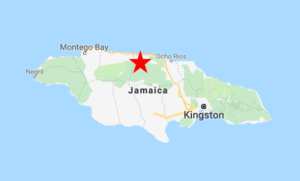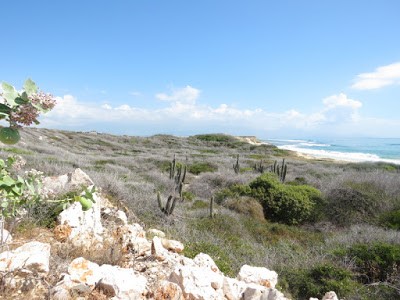Hellshire Hills, Jamaica

The Hellshire Hills are a searing wilderness of arid scrub and woodland on the edge of Kingston, historically spared from development by the harshness of the limestone terrain. Legally protected since 1999, this natural refuge sustains the last relict population of Jamaican Iguana, and has produced unconfirmed reports of Jamaican Pauraque, which is thought to have gone extinct in the mid-1800s. Pending resurrection of the endemic nightjar, Hellshire’s main ornithological attraction is the Bahama Mockingbird.
Orientation
Directions
The Hellshire Hills abut the western extension of Kingston called Portmore, about 15 minutes’ drive from downtown Kingston, or 30 minutes from Norman Manley International Airport.
From Kingston. Follow the main thoroughfare along the waterfront—its name changes from the Glasspole Highway to Port Royal Street and eventually Marcus Garvey Drive. As you pass the small Tinson Pen airfield on your right, keep to the left lane and continue straight as the road becomes the Port Kingston Causeway (if you keep to the right, Marcus Garvey Drive will take you back to the city).
After crossing the causeway, immediately after the toll plaza, take the left exit onto Fort Augusta Drive and proceed 2 km to the Port Henderson roundabout at the outer edge of the Hellshire Hills.
Some visitors will want to stop at Port Henderson and walk through the ruins or explore the short coastal road to its end at Dream Beach. Turn left (south) at the roundabout and the Port Henderson ruins will be on your right.
To press onward to Hellshire, instead of turning left at Port Henderson, proceed straight (west) through the roundabout as Fort Augusta Drive becomes Naggo Head Drive, then continue straight through the next roundabout, as the same road becomes Port Henderson Road. 1.2 km past the second roundabout, stay in the left lane, which veers left at the fork onto Braeton Road. After 800 m, again remain in the left lane to veer left (south) onto Hellshire Main Road—which leads to all points Hellshire.

Hellshire vista. © Richard Fairbank
Birdfinding
The main target species, Bahama Mockingbird, Stolid Flycatcher, and Jamaican Mango, are generally common throughout the Hellshire Hills, so one representative patch of habitat may be as good as another, but there are few established points of entry into the thorny scrub.
Continuing south from the Fort Clarence roundabout, the road bends to the right and arrives at the Hellshire Beach roundabout. After another 3 km, just past the entrance to Two Sisters Cave, you will arrive at a corner, where a dirt road continues to the south, a rough track leads west into the hills, and another short stretch of paved road leads north to a small housing development. Most visitors park at this corner and walk farther south on the main dirt road.

Bahama Mockingbird in the Hellshire Hills. © Tom Davis

Portmore Ponds. One of Jamaica’s best spots for waterbirds is the Greater Portmore Sewage Ponds, passed en route to Hellshire. On Hellshire Main Road about midway between Braeton Road and the Great Salt Pond, take SE 4th Street west over the canal. To reach the ponds, take either SE 44th Place or Lower West Henderson Boulevard south—these roads access the eastern and western portions of the ponds, respectively.
Services
Accommodations
There are few well established accommodation options in the immediate vicinity of the Hellshire Hills and Portmore. Central Kingston has many hotels, spanning the spectrum of comfort and expense, although most of the options tend to be clustered at the low and high ends of the spectrum, with relatively few in the mid-range.
The Kingston hotel that birdwatchers have most often used over the years is the Mona Visitors’ Lodge on the campus of the University of the West Indies, which has spacious grounds and provides quick access to the roads to Hardwar Gap and Mavis Bank. As it is located on the opposite side of Kingston from Hellshire, the drive across the city takes about 45 minutes (20 km), traffic permitting.
More centrally located and economical options include the Jasmine Inn and The Gardens.
Also centrally located and a little more upscale, but still affordable to most foreign travelers, are the Christar Villas Hotel, the Prestige Hotel, and the Liguanea Club.
Food
In Fort Clarence Beach, Andre’s Fish Den is open all day and generally receives favorable reviews.
Notes
The Hellshire Hills are often extremely hot during most of the day, so it is best to arrive as close to dawn as possible and bring plenty of water. The vegetation is extremely thorny, so jeans and a sturdy shirt with long sleeves are recommended in case of incidental contact.
Fort Clarence and Hellshire Beach have seen incidents of violent crime in recent years. This is sporadic and has not targeted foreigners, but visitors should be aware of the potential danger. As a precaution, it may be wise to avoid the beach communities here after dark.